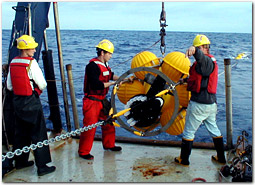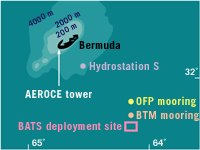 |
Science Highlights > Seasons in the Deep Ocean
Seasons in the Deep Ocean
 |

Click to enlarge
|
|
Associate Scientist Maureen Conte, left, and crew deploy a sediment trap. (Photo by Sean Chamberlin) |
In 1977, while studying microscopic marine animals called foraminifera, WHOI geochemist Werner Deuser (below) decided to try something new. He would use a newly developed technology—a funnel-shaped sediment trap—moored at 3200 meters (10,560 feet) off Bermuda to collect the tiny animals as they sank. Within a year, Deuser realized the amount and kind of material in his sediment trap told a story no one at that time thought possible: Far from being a highly stable, unchanging environment, the deep ocean experiences seasonal changes directly connected to the seasonal patterns in the upper ocean. The study has changed oceanographers’ views of ocean processes and has become the longest running time-series experiment of its kind—the Oceanic Flux Program (OFP).

Click to enlarge
|
 |
|
Geochemist Werner Deuser in 1977, now Scientist Emeritus in Marine Chemistry and Geochemistry. (Photo by Vicky Cullen)
|
Studied by researchers worldwide, and funded by the National Science Foundation, OFP samples provide critical information on how the ocean’s carbon cycle operates and is influenced by climate.
Times-series work takes tremendous dedication. Since 1994, Associate Scientist Maureen Conte, now the principal investigator of the program, has visited Bermuda every four months to recover and reset the OFP mooring (above). Conte examines the connections between upper ocean physical, chemical, and biological processes and the flux and composition of material that reaches the deep sea. She found that short-lived phenomena, such as the passage of storms and eddies, can generate large pulsed fluxes of fresh organic material and may be a major factor controlling the long-term average flux of organic materials and associated elements through the water column.
 |

Click to enlarge
|
|
Atmospheric and oceanic sampling stations near Bermuda. Deuser deployed his sediment trap near Hydrostation S, in place since the 1950s, to use its hydrographic information when analyzing samples. Today Conte uses data from several sample areas. |
Today, Conte’s analyses exploit the synergy among several ongoing research programs operating near Bermuda (right)—the Bermuda Atlantic Time-series Study (BATS), the Bermuda Testbed Mooring (BTM) Program, and atmospheric programs—to explore interrelationships among upper ocean processes and the export of material and energy to the deep ocean.
|
